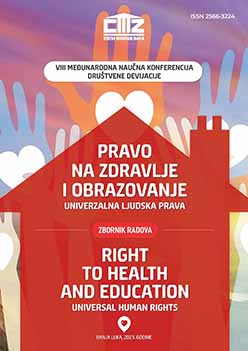RAZLIKE U IZRAŽENOSTI POTENCIJALNO PROBLEMATIČNIH PODRUČJA UČENIKA (POSIT) U ODNOSU NA NJIHOVE SOCIO-DEMOGRAFSKE KARAKTERISTIKE
THE DIFFERENCE IN POTENTIAL PROBLEM BEHAVIORS (POSIT) WITH REGARD TO THE SOCIO-DEMOGRAPHIC CHARACTERISTICS AMONG STUDENTS
Author(s): Žana VrućinićSubject(s): Sociology, School education, Social differentiation, Substance abuse and addiction, Social Norms / Social Control
Published by: CENTAR MODERNIH ZNANJA
Keywords: POSIT; sociodemographic characteristics; students;
Summary/Abstract: Children and the young people in Bosnia and Herzegovina constitute a vulnerable population, as they live with their parents, some of whom, having gone through a four-year war(1991-1995), suffer from untreated PTSD. Given that the mentioned circumstances make them susceptible to problems in numerous areas of psychosocial functioning, they need continuous monitoring in this context. In this regard, the aim of this study is to determine the differences in the expression of potentially problematic areas of adolescents measured by a questionnaire Problem-Oriented Screening Instrument for Teenagers (POSIT; Rahdert, 1991), with regard to gender, age, place of residence, number of children in the family and family structure, among students, in order to identify potential problems and prevent difficulties in psychosocial functioning in 10 areas: substance use/abuse, physical health, mental health, family relations, peer relations, educational status, vocational status, social skills, leisure/recreation, and aggressive behavior/delinquency. The sample in this research was convenient and consisted of 789 students, of which 471 were elementary school students and 318 were secondary school students from the Republic of Srpska. The research results show that there are statistically significant differences in functioning in the area that covers drug use/abuse, peer relations, professional status, mental health and leisure and recreation, with regard to the categorical independent variable gender. When it comes to the age, statistically significant differences were observed in following area of functioning: drug use/abuse, physical health, relationships with peers, professional status, and aggressive behavior and delinquency. Considering the independent categorical variable place of residence, statistically significant differences in the area of functioning of family relations were found. Respondents differ in the areas of functioning related to the physical and mental health, relationships with peers, social skills and education, considering the number of children in the family. The independent categorical variable family structure divides respondents according to functioning in the following areas: physical health, relationships with peers, and aggressive and delinquent behavior. The paper discusses the theoretical and practical implications of these findings.
Journal: DRUŠTVENE DEVIJACIJE
- Issue Year: VIII/2023
- Issue No: 8
- Page Range: 91-102
- Page Count: 12
- Language: Bosnian, Croatian, Serbian

